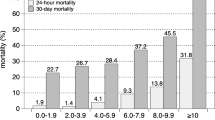Abstract
Introduction
Blood lactate concentration predicts mortality in neonates, infants, children and adults, with evidence that it has better predictive power than other markers of acid–base status such as absolute base excess or pH.
Objective
To investigate whether blood lactate concentration on admission predicts mortality in paediatric intensive care and if its addition can improve the performance of the Paediatric Index of Mortality 2 (PIM2) mortality prediction score.
Design and setting
Retrospective cohort study in one 20-bed UK paediatric intensive care unit (PICU) using data from the PICU clinical and blood gas analyser databases between 2006 and 2010. Only cases with a blood lactate concentration measured at the same time as the PIM2 variables were included. Logistic regression was used to assess if blood lactate concentration predicted mortality independently of PIM2, adjusting for potential confounders, and if it could replace absolute base excess in the PIM2 model.
Results
There were 155 deaths amongst 2,380 admissions (6.5 %). Admission lactate in non-survivors was higher than in survivors (mean [standard deviation, SD]) 6.6 [5.6] versus 3.0 [2.5] mmol/l, had a positive association with mortality [adjusted odds ratio (OR) for death per unit (mmol/l)] increase 1.11 [95 % confidence interval (CI) 1.06–1.16; p < 0.001] and significantly improved the model fit of PIM2 when it replaced absolute base excess (p < 0.001).
Conclusions
PICU admission blood lactate concentration predicts mortality independently of PIM2. Given the limitations of this study, a prospective multi-centre evaluation is required to establish whether it should be added to the PIM2 model with or without replacement of base excess.


Similar content being viewed by others
References
Shann F, Pearson G, Slater A, Wilkinson K (1997) Paediatric index of mortality (PIM): a mortality prediction model for children in intensive care. Intensive Care Med 23:201–207
Pollack MM, Ruttimann UE, Getson PR (1988) Pediatric risk of mortality (PRISM) score. Crit Care Med 16:1110–1116
Slater A, Shann F, Pearson G, For the PIM Study Group (2003) PIM2: a revised version of the paediatric index of mortality. Intensive Care Med 29:278–285
Pollack MM, Patel KM, Ruttimann UE (1996) PRISM III: an updated pediatric risk of mortality score. Crit Care Med 24:743–752
Phillips LA, Dewhurst CJ, Yoxall CW (2011) The prognostic value of initial blood lactate concentration measurements in very low birthweight infants and their use in development of a new disease severity scoring system. Arch Dis Child Fetal Neonatal Ed 96:F275–F280
Deshpande SA, Ward Platt MP (1997) Association between blood lactate and acid-base status and mortality in ventilated babies. Arch Dis Child Fetal Neonatal Ed 76:F15–F20
Hatherill M, Waggie Z, Purves L, Reynolds L, Argent A (2003) Mortality and the nature of metabolic acidosis in children with shock. Intensive Care Med 29:286–291
Duke TD, Butt W, South M (1997) Predictors of mortality and multiple organ failure in children with sepsis. Intensive Care Med 23:684–692
Hatherill M, McIntyre AG, Wattie M, Murdoch IA (2000) Early hyperlactataemia in critically ill children. Intensive Care Med 26:314–318
Jansen TC, van Bommel J, Schoonderbeek FJ, Sleeswijk Visser SJ, van der Klooster JM, Lima AP, Willemsen SP, Bakker J, LACTATE study group (2010) Early lactate-guided therapy in intensive care unit patients: a multicenter, open-label, randomized controlled trial. Am J Respir Crit Care Med 182:752–761
García Sanz C, Rupérez Lucas M, López-Herce Cid J, Vigil Escribano D, Garrido Cantarero G (2002) Prognostic value of the paediatric index of mortality (PIM) score and lactate values in critically-ill children. An Esp Pediatr 57:394–400
Stata Corporation (2007) Stata Statistical Software Release 10. Statacorp, College Station
Parslow RC, Tasker RC, Draper ES, Parry GJ, Jones S, Chater T, Thiru K, McKinney PA, Paediatric Intensive Care Audit Network (2009) Epidemiology of critically ill children in England and Wales: incidence, mortality, deprivation and ethnicity. Arch Dis Child 94:210–215
Paediatric Intensive Care Audit Network (2010) Paediatric Intensive Care Audit Network National Report 2007–2009. Available from: http://www.picanet.org.uk/Documents/General/Annual%20Report%202010/2010%20PICANet%20Annual%20Report.pdf. Accessed 25 Jan 2011
Kruse O, Grunnet N, Barfod C (2011) Blood lactate as a predictor for in-hospital mortality in patients admitted acutely to hospital: a systematic review. Scand J Trauma Resusc Emerg Med 19:74
Frey B, Losa M (2001) The value of capillary whole blood lactate for blood transfusion requirements in anaemia of prematurity. Intensive Care Med 27:222–227
Murdoch IA, Turner C, Dalton RN (1994) Arterial or mixed venous lactate measurement in critically ill children. Is there a difference? Acta Pediatr Scand 83:412–413
Weil MH, Afifi AA (1970) Experimental and clinical studies on lactate and pyruvate as indicators of the severity of acute circulatory failure (shock). Circulation 41:989–1001
Bakker J, Coffernils M, Leon M, Gris P, Vincent JL (1991) Blood lactate levels are superior to oxygen-derived variables in predicting outcome in human septic shock. Chest 99:956–962
Vincent JL (1995) Lactate levels in critically ill patients. Acta Anaesthesiol Scand 107:261–266
Acknowledgments
We would like to thank all the staff in the participating hospital who have collected data for PICANet. We are grateful to the UK Paediatric Intensive Care Society for continued support and to the members of the PICANet Steering Group and Clinical Advisory Group who are listed on our website: http://www.picanet.org.uk/participants.html. PICANet is funded by the National Clinical Audit and Patient Outcomes Programme via the Healthcare Quality Improvement Partnership (HQIP), Health Commission Wales Specialised Services, NHS Lothian/National Service Division NHS Scotland, the Royal Belfast Hospital for Sick Children, Our Lady’s Children’s Hospital, Crumlin, Dublin, Children’s University Hospital, Temple Street, Dublin and The Harley Street Clinic, London.
Conflicts of interest
There are no conflicts of interest affecting the work presented here.
Author information
Authors and Affiliations
Corresponding author
Rights and permissions
About this article
Cite this article
Morris, K.P., McShane, P., Stickley, J. et al. The relationship between blood lactate concentration, the Paediatric Index of Mortality 2 (PIM2) and mortality in paediatric intensive care. Intensive Care Med 38, 2042–2046 (2012). https://doi.org/10.1007/s00134-012-2733-7
Received:
Accepted:
Published:
Issue Date:
DOI: https://doi.org/10.1007/s00134-012-2733-7



